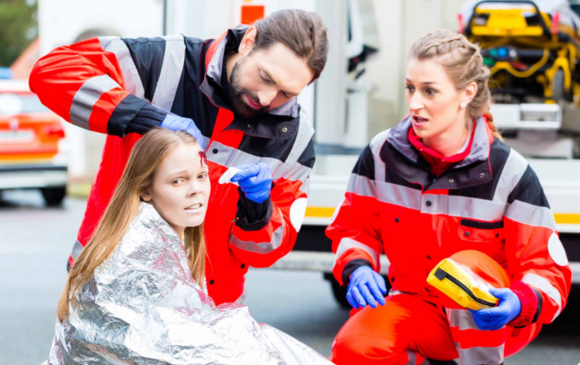
Although 86% of 9-1-1 calls are made through wireless devices according to the National 911 Progress Report, our heroes in uniform don’t have access to all the amazing modern technology that we take for granted at the palms of our hands. In this article we discuss how getting eyes on the scene of the emergency (e.g. via Carbyne’s patented live caller video) can positively and dramatically improve situational awareness for call-takers, dispatchers, police officers, firefighters, and paramedics alike.
Call-Takers: America’s Public Safety Answering Points (PSAPs) are staffed by two critical functions: call-takers and dispatchers. Call-takers are our true First Responders in every sense of the word, since they are the first people that respond when we call 9-1-1. Call-takers have the thankless job of calming us down in our moment of panic, and trying to determine the nature of our emergency so they can help dispatch the right field response to our aid. If eye-witness testimony is unreliable, one can only imagine the potential for misinterpretation when a caller who has just experienced an emergency is trying to describe the scene to the call-taker. Instead of a verbal description of the scene, modern technology enables call-takers to get live video streamed from the caller’s phone, taking misinterpretation errors out of the emergency response equation. All a call-taker needs to make this happen is a cloud-native call-handling system like Carbyne that supports live video without needing to download an app.
Dispatchers: If call-takers are the calming voice at the other end of the line, dispatchers are the operators who direct field responders (police officers, firefighters, and paramedics) to the caller’s aid. While large PSAPs have separate and distinct staff who handle call-taking and dispatching functions, many smaller PSAPs have the same heroes handling both functions of call-taking and dispatching. Regardless of the setup, the possibility of misinterpretation between the caller and call-taker using verbal communication is unfortunately amplified in the call-taker to dispatcher communication when this is verbal. Live video from the caller that is accessible to the dispatcher further ensures that when she is directing field responders to the scene, she has total situational awareness to ensure effective response.
Police Officers: According to the FBI Crime Data Explorer, we have witnessed an alarming 35% increase in the nation’s homicide rate over the past decade. Our law enforcement officers put themselves in harm’s way every day on the job since they have no guarantee they will arrive home unharmed at the end of their shift. When responding to emergencies, police officers have to make split-second decisions about the use of force and the level of risk they are taking on themselves. While hearing about the situation verbally as relayed from the caller to the call-taker to the dispatcher can provide some basic situational awareness, live video from the caller transmitted directly to the police officer’s mobile device without having to download an app can mean they arrive on the scene with total situational awareness and maximize their chances of effectively dealing with the emergency at hand.
Firefighters: Of the more than 1 Million firefighters in the nation, 67% are volunteer firefighters according to the National Fire Protection Association (NFPA). These heroes in uniform arrive on scene every day putting themselves in harm’s way, and sadly around one in five firefighter fatalities are on scene at non-fire calls according to NFPA. Hearing about a fire incident verbally conveyed from the caller to the call-taker to the dispatcher to the firefighter unfortunately leaves a large opportunity for miscommunication and firefighters may arrive unnecessarily or unprepared. Having live caller video directly transmitted to the firefighter’s mobile phone without having to download an app can mean they can assess the situation beforehand and decide either that it is not necessarily a fire incident or arrive fully equipped with the right equipment to ensure the safety of firefighters and callers alike.
Paramedics: There are over 173,000 paramedics across the nation according to Zippia. Whether a caller is experiencing a heart attack or has suffered a fall, these heroes are able to provide essential medical care until the caller can be transferred to a hospital or clinic. Given that our nation has only around one paramedic for every 1,800 people, these heroes are often understaffed and have multiple medical emergencies they have to respond to. Performing triage upon arrival based on verbal communication from the caller to the call-taker to the dispatcher to the paramedic can unfortunately result in under-dispatching or over-dispatching and ultimately inefficient emergency medical response. With live caller video, paramedics can visually assess the patient prior to arrival and ensure they triage effectively and deliver the right care to the right patient at the right time.
Whether you are a caller experiencing an emergency, a call-taker, dispatcher, police officer, firefighter, or paramedic, Carbyne is committed to providing you with the latest in modern technology including patented live caller video so you can do what you do best, because every person counts.
Carbyne (Headquartered in New York, NY) is a leading global provider of cloud-native mission-critical contact center solutions. Carbyne is one of the largest rich-data providers for emergency response centers, delivering over 250M data points per year all in a unified platform. Our technologies enable emergency contact centers and select enterprises to connect with callers as well as connected devices via highly secure communication channels without needing to download a consumer app. With a mission to redefine emergency collaboration and connect the dots between people, enterprises and governments, Carbyne provides a unified cloud native solution that provides live actionable data that can lead to more efficient and transparent operations and ultimately save lives. With Carbyne, Every Person Counts.